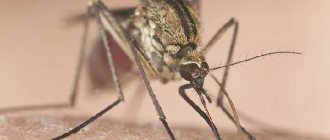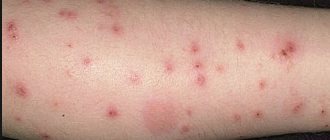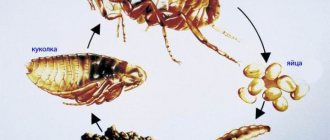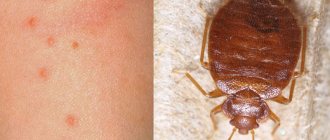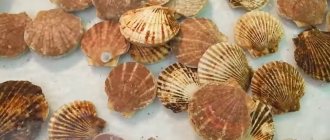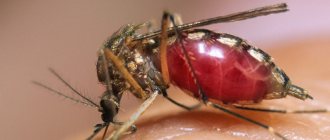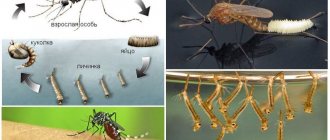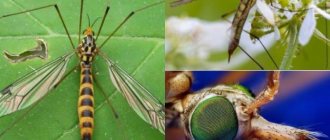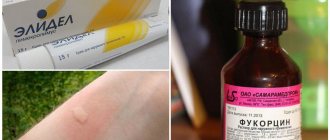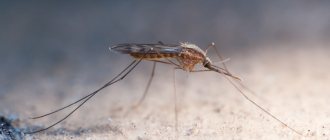Appearance
This insect is usually classified as a member of the vile complex, which designates the subfamily of Diptera and long-whiskered. The body size of mosquitoes does not exceed 4 millimeters. Their color cannot be called bright; in nature they are found in different colors and shades: from transparent white to dark brown. A mosquito can take on a different color if its body contains blood that has been sucked from the “victim.” His legs and trunk are long. Mosquitoes have black eyes and antennae on their heads. A distinctive feature of this insect is that at rest its folded wings are raised above the abdomen at an angle of 450. The entire body is covered with hair.
Mosquito photo Even though mosquitoes have wings, they most often move by jumping. These insects fly weakly, and the maximum speed they develop is 4 m/s.
Galileo. Mosquitoes: Video
With mosquitoes everything is much simpler. In Spanish, mosquito is a small fly. In the 18th century in the southern United States, the word passed into the English language and today all English speakers call our mosquitoes exclusively mosquitoes.
The mosquito community usually includes Anopheles anopheles mosquitoes, Aedes biting mosquitoes, etc. All of these insects belong to the group Nematocera (Long-whiskered) of the order Diptera (diptera). Here, by the way, lies scientific cunning. In fact, both mosquitoes and mosquitoes have four wings, but one pair is underdeveloped and has turned from an organ of movement into an organ of balance - the halteres.
Mosquito development
Mosquito development occurs in 4 stages:
- Egg;
- Larva;
- Pupa;
- Imago.
As an adult, the female mosquito begins to feed on blood in order to lay eggs. In normal times, this insect feeds on natural sugar. Males do not drink blood. The egg matures in 6 to 8 days. In total, the female lays from 30 to 60 eggs at a time. This process depends on the temperature around the future larva, the rate of blood digestion, as well as its type. Scientists are still investigating where the female lays her eggs, after the future larvae are placed in a safe place - the female dies. The area favorable for breeding should be moist, cool, and there should be organic matter nearby. Thus, in arid regions, mosquitoes were found in the burrows of wild animals, as well as in crevices in the upper layers of the earth. Females can also lay eggs in water without harming future mosquitoes. Insects can hatch in an aquatic environment and live in it for up to 5 days; there are certain species that can live in water for up to 14 days. The larvae can then emerge to the surface. Without access to water for 24 hours, they die, which is why it is so important for them to exist in moist soil.
The transformation from larva to doll occurs on a massive scale. At the same time, all insects of this species move to the next stage of development. This occurs in late spring or early summer. The period of development and maturation of the pupa lasts several months, but the process can also drag on for a year. After the pupal stage is completed, the mosquito becomes an adult, and the females are ready to give birth. Adults feed on flower nectar.
Reproduction process
Mosquitoes reproduce like mosquitoes, undergoing 4 stages of development: egg, larva, pupa and adult. To reproduce, the female needs a portion of blood, after which she lays eggs within a week, making 3 clutches over the summer. Legless larvae and mobile pupae of mosquitoes live in stagnant waters. In contrast, the mosquito adult develops in relatively dry places, but with the required level of humidity. The larvae use organic debris as food. They become sexually mature after 90 days.
Mosquito development
The female lays an egg, which is gradually fed with blood. Insects lay eggs preferably in cool, damp places. These could be animal burrows or cracks in the soil. After approximately 8 days, the egg enters the larval stage. The main parameter necessary for the development of larvae is high soil moisture. At the end of spring, the larvae enter the pupal phase; later, a large number of adults emerge from these pupae simultaneously.
In general, it is quite difficult to follow the natural life of a mosquito. All studies were carried out mainly in laboratory conditions. Therefore, it is not possible to draw accurate conclusions about the characteristics of these insects. Scientists can only give speculative characteristics of the life of mosquitoes.
Types of mosquitoes, mosquito habitats
Today, researchers count more than 700 different species of mosquitoes, many of which can carry diseases. The most famous of them are:
- Phlebotomuses;
- Lutzomyia.
These insects can be found in warm climates. They are common on almost all warm continents, but they have not been found in New Zealand and the Pacific islands. The most favorite habitat is the tropics and subtropics. In Russia, mosquitoes live in the southern regions: in Crimea, Krasnodar and Stavropol Territories. They are also found in the tundra. Females lay eggs in places close to other living creatures. Thus, insects do not have to look for food and travel far to get it.
Habitat for mosquitoes and mosquitoes
Mosquito and mosquito
Mosquitoes live in almost all corners of the planet, with the exception of the extreme regions of the south and north poles. They prefer damp places, stagnant bodies of water and relatively warm climates. But in harsh winter conditions, some representatives of mosquito species can hibernate and wait out unfavorable times.
Mosquitoes live in warm countries with tropical climates. They are found in Asia, Africa, Latin America, and southern Europe. In Russia, you can become a victim of a mosquito while in the subtropical regions of the Caucasus, Abkhazia, and Krasnodar Territory. Mosquitoes also need proximity to a source of fresh water.
Mosquito bite
At different stages of development, mosquitoes feed on:
- Mushrooms
- Decaying leaves
- excrement
- Decaying dead insects
- Plant juices
- Honeydew
- Any sweet liquids
Only females drink blood and only for reproduction. The level of blood saturation determines the number of eggs that a mosquito can lay. On average, the female lays from 30 to 70 pieces at a time.
Mosquitoes bite mainly at dusk, when air humidity rises. If the pest lives indoors, then bites can occur during the day. The insect does not fly very well, so even a weak wind can become a serious obstacle to movement.
A mosquito bite may or may not be felt depending on the situation, but a mosquito bite is always painful and is always felt.
- The size of the redness around the bite depends on the individual characteristics of the organism and can reach a diameter of more than 10 centimeters.
- A lump or blister may appear at the site of the bite.
- The bites become swollen, itchy and itchy, causing mosquito dermatosis.
- Mosquito saliva, which prevents blood clotting during feeding, can cause allergies.
- Bites can appear one at a time or en masse at once.
Mosquitoes prefer to fly closer to ground level, so bites often appear on your feet or after you have been lying on the sand or sitting at ground level.
More details
Culex mosquitoes usually land on the skin, immediately and accurately choosing places where the capillaries are as close to the surface as possible. Mosquitoes do not possess such sniper talents. Their females make several jumps before finding the right place. The mosquito or mosquito then inserts its stinging proboscis into the skin and drinks the blood. The angle of the injection can be different and depends on the type and size of the insect. Male mosquitoes and gnats are not interested in blood; their proboscis is soft and short, suitable only for drinking nectar from plant flowers.
By injecting a hemostatic substance into the wound, the female insect transmits to the victim a huge number of microorganisms - viruses, bacteria, protozoa, microscopic larvae of round filaria worms. The overwhelming number of uninvited guests are destroyed by the body's immune cells, hastily summoned to the site of the bite. But some enemies are able to break through and cause infection. Mosquitoes are carriers of dangerous diseases such as malaria, tularemia, yellow fever, and viral hemorrhagic fevers. Mosquitoes carry tularemia, encephalitis, and parasitic infestations.
Insect bites
Insect bites
Both types of bloodsuckers are dangerous to humans and other living beings. Depending on the sex, the diet of mosquitoes is different. The females of these insects must feed on blood to form eggs in their bodies. Males are harmless creatures that feed on plant nectar.
Before biting her victim, the female mosquito makes several jumps on the skin, then plunges her proboscis under the skin. When she bites, she injects a blood thinner, just like a female mosquito.
Mosquitoes are carriers of dangerous diseases:
- leishmaniasis;
- mosquito fever;
- bartonellosis and others.
They cause the greatest harm to livestock. Huge clouds of mosquitoes can cover an entire herd of cattle overnight and cause the animals to die. They are as dangerous to humans as mosquitoes. Both types of insects are similar in some ways, but also have certain differences.
Reproduction
Mosquito development occurs in four stages:
- egg;
- larva;
- chrysalis;
- imago.
The female lays her eggs in a cool, moist place with access to nutrients. Most often, their temporary “home” is moist soil, burrows of small rodents and other insects. In laboratory conditions, an excellent environment for them was the excrement of birds and rabbits. One individual lays 30-60 eggs at a time.
For the maturation and successful development of future mosquitoes, they need blood, which is constantly brought to them by a caring mother. The egg stage lasts from 4 days to a week, these times vary depending on the type of mosquito. At the very beginning of life, there is a special horny outgrowth on the head of the cubs, designed to open the strong shell of the egg. It is reset immediately after hatching.
A mosquito larva is a light-colored creature that looks like a tiny caterpillar. It has four stages of development, during which its appearance and size change. The transition to each new phase is accompanied by molting.
Reproduction nuances
The difference between a mosquito and a mosquito can also be traced in the characteristics of reproduction. Most mosquito species breed directly in water. They lay eggs there, which later develop into larvae. The larvae feed on microorganisms and small algae in the pond, then turn into a pupa. From the pupal stage, the mosquito turns into a fully formed individual and takes off from the surface of the water.
Interesting!
Some types of mosquitoes lay their eggs in the soil. All stages of maturation occur in the ground. The larvae feed there on plant particles or root crops.
Mosquitoes raise their young in well-moistened soils rich in organic compounds. Scientists studying these representatives of dipterans have noted that females prefer to lay eggs near manure heaps and garbage dumps. The voracious larvae consume the organic waste around them.
Peculiarities of mosquito behavior
The difference between mosquitoes and mosquitoes lies in the peculiarities of their life activity. Mosquitoes can annoy people almost all day long.
Mosquitoes have a certain time of day for this - they go out for their daily hunt as soon as the sun begins to set below the horizon.
This time, and after another hour, the insects show their unprecedented activity; cases have been recorded when mosquitoes gathered in a whole swarm, which could easily surround a pet from all sides. In human dwellings, mosquitoes can bite throughout the day.
Mosquitoes choose places of their bite mainly on those parts of the body where there is no clothing.
In large quantities they can get into the ears, folds of the skin, and nostrils.
Only the female sucks the blood of a person or animal. Having chosen a victim, the female makes several jumps on the skin, releases her proboscis and pierces it.
A special substance is released from the mosquito's proboscis; it thins the blood and makes the process of absorbing viscous liquid a matter of seconds. Males are not bloodthirsty and feed on plant sap and organic matter.
To reproduce, the female needs to drink blood - after which she lays eggs in a dark place for 5 - 10 days.
The eggs hatch into larvae that, before turning into adults, live in the ground and feed on organic debris. Full sexual maturity is reached after about three months. The female is capable of laying three clutches during the summer season.
The greatest activity of mosquitoes begins to be observed in mid-July and in August.
Interesting facts about mosquito and mosquito
Surely you haven’t looked at these little predators. I wish I could slam it quickly and that’s it.
The structure of dangerous insects is quite common:
Most of the head is occupied by two large eyes. Each of which consists of many lenses. They allow the mosquito to see in several directions simultaneously. That's why when you try to kill him, you almost always miss.
A person can only see in one direction, and peripheral vision makes it possible to slightly follow what is happening to the sides. Imagine looking left and right at the same time. It would be great.
- This small predator has only one pair of wings and 6 legs
- Markings on the belly clearly indicate belonging to one species or another.
- Length about 16 mm
- And the average mosquito weighs only 2.5 milligrams
Who bites: women or male mosquitoes?
- The main food for all types of these insects is sweet nectar of flowers and plant juice.
- In one bite, the female drinks a volume of blood that exceeds her own weight by 6 times.
Only mosquitoes bite. Females need protein to reproduce. And nature found such a simple way: to obtain it from the blood of animals and people. Fur protects animals from bites. And the human body is completely at the disposal of little vampires. Therefore, people are their main food.
Only females make a nasty itching sound.
This is where the expressions came from: “... annoying like a mosquito...”, “... don’t itch like...”.
Differences from mosquitoes
Mosquitoes are often confused with mosquitoes. Even on the Internet, information about them is often presented as representatives of the same species. This is absolutely false. Mosquitoes, although they belong to dipterous long-whiskered insects, represent a separate family. They also have long legs and a proboscis, and also feed mainly on plant juices. This is where the main similarities end.
Mosquitoes differ in appearance due to their light shades of color and shaggy body. In size they reach up to 3 mm, while mosquitoes grow up to 5 mm. In a calm state, the wings of mosquitoes are slightly raised, located at an angle. In mosquitoes, on the contrary, they fold parallel to the body, completely lying along the back.
Although the mosquito range reaches the temperate zone, it is still much narrower. They are heat-loving, so they inhabit hot southern countries. Mosquitoes live everywhere except Antarctica. They are much faster and noisier; during flight they emit an annoying buzzing and squeaking sound. Mosquitoes are poor and slow flyers and are very quiet. In Italy, they even received a nickname, which translates to “bites silently.”
Mosquitoes, unlike mosquitoes, do not carry malaria pathogens, but they infect victims with other parasites. Before piercing the skin with their proboscis, they make several jumps in search of the best place to bite. Mosquitoes do not jump, but bite immediately and then crawl over the host’s body.
Mosquitoes: description and types
According to various estimates, there are from 300 to 1000 species of mosquitoes.
At the same time, detailed information about them is almost impossible to find in the public domain. They belong to two-winged, long-whiskered insects from the butterfly family. Mosquitoes are very small insects that are yellowish or gray-brown in color. They have long legs, elongated oval wings, the size of which is almost equal to the length of the body. The insects are covered with small hairs and look slightly shaggy. Hairs even grow along the edges of the wings.
Mosquitoes have black eyes. Their nose is strongly extended forward and turned into a proboscis, with which they feed. Male mosquitoes are exclusively herbivorous insects. They consume flower nectar, plant sap, and honeydew, a sweetish sap secreted by aphids. Only females bite. With their proboscis they pierce the skin of animals and suck out some blood.
Mosquito and mosquito: differences in structure and appearance
Many of us are accustomed to thinking that a mosquito is a huge insect with a long nose; in fact, this is not entirely true.
Peculiarities:
- The length of the mosquito body is only 3 mm. That is, he is very tiny. In this case, the body length of a mosquito can reach 1 centimeter.
- To differentiate, you need to pay attention to the wings. In a mosquito, they stick out and are located at approximately a 90-degree angle to the body. The mosquito's wings, in turn, lie on the body, almost parallel to it.
- To determine, you can also look at the color of the abdomen. In a mosquito it can be white and even golden. The average mosquito has a brown or greenish body. There may be some gray flecks.
- Both mosquitoes and mosquitoes bite quite painfully, but the bite technique is somewhat different. The fact is that the mosquito's saliva contains a special substance that thins the blood, making it more fluid.
- Accordingly, after a mosquito bite, redness and a swollen spot are observed. Very often, bites are confused with allergies or a midge bite. The lesion is very similar to a button after a Mantoux vaccination. And after a mosquito bite, there is simply a red dot if there is no allergic reaction.
Mosquitoes: photo
The life cycle of mosquitoes includes 4 stages: egg, larva, pupa, and adult. The period during which a hatched mosquito fully grows largely depends on temperature conditions and can last on average from 1 to 3 months, sometimes more, due to the ability of the larvae to pause development if environmental conditions for some reason become unacceptable.
- The female lays her eggs in the ground, rodent burrows, tree roots and cracks in building materials, and not in water, as mosquitoes do.
- The mosquito larva is worm-shaped, light beige, translucent, with a dark head and several dark tail filaments at the back.
- The body size of an adult insect varies between 1.5–3.5 millimeters.
- The body of the mosquito is transparent, covered with light, randomly protruding hairs; the wings have a fringe-like edge.
- If a mosquito is sitting, its transparent wings are spread out at an angle of about 40 degrees to the body, whereas in mosquitoes they are usually located parallel to the body.
- The flight of a mosquito is a combination of jumping and periodic action of the wings, so it looks a little different than that of ordinary mosquitoes.
- Mosquitoes fly silently, but the squeak of mosquitoes is always heard.
You can see what mosquitoes look like in the photo. It can be difficult to see the pest in detail with the naked eye. In this case, the easiest way is to focus on the position of the insect’s wings - it is most visible, and the nature of the bites, if they have already appeared.
Why not mosquitoes
To understand who mosquitoes are and why they are not mosquitoes, you will have to delve a little deeper into the scientific classification. Mosquitoes and mosquitoes belong to the same order: Diptera. Then their paths diverge. The differences between mosquitoes and mosquitoes begin with their “pedigree.” Mosquitoes belong to the mosquito family, mosquitoes belong to the butterfly family.
On a note!
All blood-sucking flying insects, even the largest ones, are part of the “gnus complex”.
Butterflies are small blood-sucking insects that look similar to small moths. Because of this, the family got its name. Below is a photo of a butterfly.
Butterfly
The mosquito, not belonging to the mosquito family, looks more like a mosquito than a butterfly. A photo of a mosquito and a common mosquito will help you compare them.
Mosquito and common mosquito
The difference between a mosquito and a mosquito is clearly shown in the table.
| Comparison parameter | Mosquito | Mosquito |
| Sound | silent | characteristic ringing |
| Size | up to 4 mm | up to 15 mm |
| Wings | raised and positioned at an angle to the body | located parallel to each other and the body of the insect |
| Torso | covered with bristles | no bristles |
| Breeding sites | wet soil, burrows, caves, fruits | water |
The feeding pattern of mosquitoes and mosquitoes is the same: males drink flower nectar, fertilized females need blood.
On a note!
An adult female mosquito makes several jumps over the victim's body before biting.
Some of the species of the Eurasian genus Phlebotomus are synanthropic, that is, they have adapted to live near humans. In the city, places where mosquitoes of these species live can be damp basements. In nature, bloodsuckers of this species are most often found in the dense shade of bushes or undergrowth. Although the larvae do not live directly in water, they need soil saturated with moisture. In the absence of direct contact with water, they die within 24 hours.
What diseases do mosquitoes carry?
Due to their lifestyle, mosquitoes in tropical countries are carriers of a number of dangerous diseases:
- Leishmaniasis
- Bartonellosis
- Pappataci fevers
These bacterial and viral diseases are potentially dangerous to both people and animals.
What diseases mosquitoes carry depends on where they live. If parasites continue to migrate to Europe and Russia, it is quite possible that the list of diseases transmitted by their bites will expand, be supplemented or change in some way.
Where do mosquitoes live?
Mosquitoes are found mainly in tropical and subtropical climates, sometimes in temperate ones. There are places where mosquitoes live in more than 80 countries around the world, including:
- India
- Brazil
- Colombia
- Costa Rica
- Peru
- Spain
- Türkiye
- Tunisia
- Iran
- Sri Lanka
- Algeria
- Egypt
- Israel
- Nepal
- Bangladesh
- Kenya
- China
- Morocco
- Italy
- Georgia
- Abkhazia
In these tourist countries, the most frequently reported cases of infection are leishmaniasis, a bacterial disease transmitted by mosquitoes. It was not by chance that the tourist destinations were mentioned. In Russia, according to official statistics, all cases of leishmaniasis infection are imported. Mosquitoes are found in Sochi and some areas of the Black Sea coast, but transmission of leishmaniasis has not yet been recorded there.
If in the Central region of Russia, Moscow or the Moscow region you are bitten by mosquito-like insects, then most likely they are not mosquitoes, but representatives of midges. These could be mosquitoes, flesh-eating midges, midges, horseflies
, burner flies and the like. All of these insects bite, but the harm they can cause to humans is different from the damage that mosquitoes can cause.
According to scientists, due to climate change in recent years, the distribution area of mosquitoes has gradually increased. Isolated cases of bites began to be recorded in countries where the insect had not previously been found - in Croatia, Switzerland, Spain, Portugal, Germany and a number of other countries where the climate is far from tropical. For this reason, in the future, mosquitoes may appear in Russia, in any case, scientists do not exclude such a possibility.
If you are traveling to one of the countries where mosquitoes are found, or you suspect that you have already discovered the first migrants of this subfamily in Russia, a description of the appearance and characteristics of the parasites will help you make sure that it is they and no one else. What do these insects look like?
The harm and benefits of mosquitoes
Traditional opinion: there is no benefit from bloodsuckers, only harm. In fact, these small flyers, together with other similar insects, form the base of the food pyramid in any ecosystem: forest, desert, city, etc. Many species of birds, amphibians, reptiles and animals feed on the adults. The larvae, by processing organic matter rotting in the ground, contribute to the inexhaustibility of the soil.
But they can also cause significant harm to humans. Mosquito bites are painful. When bitten, the bloodsucker sprays saliva into the wound with substances that prevent blood clotting.
On a note!
If the victim has an allergy, the bite site, at best, swells greatly. At worst, death is possible. Even for those who do not suffer from allergies, mosquito bites become red, swollen and itchy for a long time. When scratching, there is a high chance of introducing an infection into the wound.
In hot regions, phlebotoderma can develop as a result of the human body's sensitivity to mosquito bites. This reaction to bites is expressed in a rash of itchy nodules all over the body.
Mosquitoes are carriers of the disease leishmaniasis. This is a parasitic disease that manifests itself in the form of ulcerative papules. In addition to leishmaniasis, mosquitoes can transmit pappataci fever and bartonellosis. All these diseases are usually common in the southern regions of Eurasia and the population of the northern part would not have to fear them. But, due to global warming, not only southern species of plants and animals, but also pathogens are moving north.
Pappataci fever is one of the most dangerous diseases. Distributed in the Mediterranean, the Balkans, the Middle East, Indochina and East Africa. It is carried by mosquitoes called fever. What do Phlebotomus pappataci mosquitoes look like:
- size 2-3 mm;
- color pale yellow;
- the wings and body are covered with light long bristles.
The bites of this type of bloodsucker are painless; a person does not notice that he has been attacked by a papal mosquito. For this reason, you may not attach importance to the symptoms of an incipient disease.
Harm to humans
There is an opinion that blood-sucking insects only cause harm and cannot be of any benefit. In fact, mosquitoes and similar creatures are the base of the food pyramid. A lot of reptiles, amphibians, animals and birds feed on them. And the larvae are engaged in processing organic particles rotting in the ground, which makes the soil inexhaustible.
But they cause great harm to humans. A mosquito bite causes pain. Together with mosquito saliva, substances that interfere with blood clotting enter the wound. The affected area swells, becomes very red and itches for a long time. In the worst case scenario, death is possible.
If a person scratches a wound, there is a risk of infection. In hot regions, the victim may develop phlebotoderma - the formation of more itchy nodules over the entire surface of the skin.
Mosquitoes are carriers of leishmaniasis. This is a dangerous disease, one of the symptoms of which is the appearance of ulcers. Insects can also carry bartonellosis and pappataci. Previously, these diseases were found only in the southern regions of Eurasia, and residents of the northern part did not have to be afraid of them. But against the backdrop of global warming, pathogens have moved north.
Pappataci fever is one of the most dangerous diseases in the world, common in East Africa, the Middle East, the Balkans and Indochina. Its carriers are the mosquitoes Phlebotomus pappataci:
- these are pale yellow insects;
- size 2−3 mm;
- their body and wings are covered with long bristles.
The bites of such bloodsuckers are absolutely painless, the victim is not even aware of the attack. That is why a person may not attach any importance to the primary symptoms of the disease.
The only way to prevent the occurrence of this serious disease is vaccination against yellow fever, which is recommended for all travelers to a number of hot countries.
Methods for controlling mosquitoes
The methods of control in this case are the same as with mosquitoes and flies:
- mechanical:
- chemical.
Mechanical methods include installing screens on windows. Not counting fly swatters, which are ineffective. It must be taken into account that the cells of a mosquito net should be smaller than those of a mosquito net. To get rid of dampness in basements, it is enough to monitor the serviceability of water and sewer pipes. The accumulation of heaps of organic waste in the surrounding area should not be allowed. This is an excellent breeding ground for mosquitoes.
Types of mosquitoes, photos and names
There are a great many different types of mosquitoes in nature; we will describe the most interesting of them:
Common mosquito (squeaker)
It is the most common representative of the mosquito family. It lives over a wide geographic range; it is these mosquitoes that often bother us during forest picnics, walks near water bodies, or even just at home.
Centipede mosquito (caramora)
These mosquitoes live exclusively in places with high humidity: near ponds, swamps, and in shady thickets. They are large in size for mosquitoes - reaching 4-8 cm in length. And these mosquitoes are also safe for humans, since they feed exclusively on nectar and plant juices, but they can cause harm to farmland and forest plantings.
Chionei (winter mosquitoes)
These mosquitoes are similar to both large spiders and centipedes. However, they differ from both of them in their way of life. They differ from other mosquitoes in their ability to tolerate cold and therefore winter mosquitoes can be found even in winter.
Also known as the bell mosquito. It is a harmless representative of the mosquito family, as it feeds exclusively on plant foods. It lives mainly along the banks of water bodies. It differs from other mosquitoes in its appearance - it has a yellowish-green color with long limbs.
What are the consequences of a mosquito bite?
Mosquito saliva contains toxic substances that provoke a strong reaction in the human body to the bite of this insect. This disease is called phlebotoderma and is most common in hot countries of the Middle East. It is also recorded in Central Asia. In temperate climates, phlebotoderma is seasonal and occurs in summer and autumn.
Depending on the nature of the course, the disease can be acute or chronic.
A few minutes, sometimes even hours after the bite, a rash appears on the skin. As a rule, it is observed on the back of the hands, forearms, lower legs, face and other open areas of the body. First, an urticarial-erythematous spot appears on the affected area. It quickly increases to the size of a 10-15 kopeck coin. After a few hours or even days, the spot turns pale and disappears completely. It happens that pinpoint hemorrhage remains in its center.
Some victims prone to allergic reactions experience symptoms of angioedema or bullous rashes. With the bullous form of phlebotoderma, erythematous-urticarial elements appear on the skin, then vesicles and large blisters, which in size resemble pigeon eggs. A 3-5 cm erythematous corolla often forms around bullous rashes. In most cases, the following symptoms develop:
- headache
- feeling weak
- poor appetite
The blisters gradually disappear after a few days.
As a rule, the rashes disappear after stopping contact with mosquitoes. However, in some people, rashes are observed over several months and years, developing into chronic phlebotoderma. The disease is characterized by hemispherical nodes from 5 to 15 mm in diameter, which are localized mainly on the extensor surfaces of the limbs, as well as on the back, lower back and buttocks. The nodules are colored brownish-gray and covered with scales and crusts. The disease may be accompanied by the addition of a pyococcal infection. Victims may suffer from neurotic disorders, insomnia, and loss of appetite caused by acute itching.
The prognosis is often favorable. However, sometimes the disease can persist for several years without responding to treatment.
Mosquitoes also transmit phlebotomy fever and other arboviral infections. Plus, when bitten, they can infect a person with cutaneous and visceral leishmaniasis, bartonellosis.
Developmental biology
Like all other dipterous insects, mosquitoes have 4 developmental phases: egg, larva, pupa, and imago. Mosquitoes usually feed on natural sugars - plant sap, honeydew, but females require blood to mature their eggs. The number of blood draws may vary depending on the type. The time it takes for eggs to mature depends on the species, the rate of blood digestion, and the ambient temperature; in laboratory conditions - usually 4-8 days. Eggs are laid in places conducive to the development of pre-imaginal stages. The pre-imaginal stages include the egg, three (or four) larval stages and the pupa. Research conducted at Ph. papatasi
and
Lu.
longipalpis showed that females are attracted to hexanol and 2-methyl-2-butanol released from chicken and rabbit droppings, and are stimulated to lay eggs by the presence of a clutch of eggs of the same kind. The breeding sites of mosquitoes have not been studied enough, but it is known that their larvae, unlike most butterflies, are not aquatic, and from observations of laboratory colonies it can be concluded that the main requirements for the breeding site are humidity, coolness and the presence of organic substances. In the arid zones of the Old World, mosquitoes live and breed in rodent burrows or in cracks in the soil.
Lutzomyia longipalpis larva
.
Most Palaearctic species are characterized by diapause, into which the larvae enter in the fourth stage. In May-June, the larvae pupate at approximately the same time, and adult insects appear immediately in large numbers.
The larvae need liquid water - placed in a test tube with water so that they remain above the water level, without direct contact with it, they die within 24 hours. Since the larvae of most butterflies are aquatic, it can be assumed that mosquito larvae have adapted to exist in moist soil. Mosquito eggs can survive in water for a long time; larvae can hatch in water and live in it for up to five days (first stage). The fourth stage survives in water for up to 14 days. Once removed from the water, they can continue to develop normally.
Most mosquitoes are active during twilight and night time. Unlike mosquitoes, they fly silently. The Italian name for the mosquito that gives its name to the type species is pappa tachi, meaning “bites silently.”
After the bite
Let's consider what to do if you are bitten by a mosquito. Of course, it’s better not to let it come to this, but since it has happened, we must be prepared to deal with the consequences of the bite.
Attention! You should absolutely not scratch the bite site, no matter how much you might want to!
And now recommendations on what to do in case of bites:
- It is imperative to wash the bite site with soap and water.
- Apply ice or a cool object.
- You can use a cut of fresh vegetables or fruits, the juice of which can disinfect the wound: onions, tomatoes.
- Use a solution of baking soda or boric alcohol.
In case of severe individual intolerance or danger of contracting an infectious disease, consult a doctor immediately. Sometimes adults are embarrassed to go to a medical facility with a trivial pimple, but this is fraught with great danger. Don’t joke with your own health, and take all necessary measures especially carefully and impeccably if a child has been bitten.
By the way! In Suriname, the country in northern South America where the famous Dutch footballer and coach, Ruud Gullit, is from, the death penalty by mosquitoes still exists. Convicts are tied naked to poles in areas infested with mosquitoes.
At the end of the day, look at how a mosquito bites a man’s hand:
What's happening
Mosquitoes are small in size. They attack humans mainly in the evening, inflicting unpleasant painful bites. The insect's mouthparts have the ability to pierce the skin. Saliva enters the wound, which contains a significant amount of foreign protein toxic compounds. They prevent blood from clotting and facilitate its entry into the insect’s digestive tract. During a bite, several pathophysiological reactions develop in the tissues:
- Direct damage to cells and intercellular substance of tissues during a bite.
- The development of inflammation, which is a protective reaction that prevents the spread of the pathological process into nearby intact tissues. Immunocompetent cells rush to the area of damaged tissue. They produce compounds called inflammatory mediators and irritate nerve fibers (pain, burning, itching), increase vascular permeability (swelling of the bite area), and also promote blood stagnation (hyperemia).
- Development of allergic reactions - in the presence of hypersensitization (increased sensitivity) of the human immune system to insect saliva, when it enters the wound, a pronounced specific pathophysiological reaction develops, which can spread beyond the tissues damaged by the bite. The development of allergies is associated with the production of a number of biologically active compounds by eosinophils, the main of which is histamine.
- Intoxication of the body - when a significant amount of insect saliva gets into the wound, it is partially absorbed into the blood. In this case, general body reactions develop, including fever.
Features of the insect
Mosquitoes are a large family of insects, which includes about 3.5 thousand species. They live all over the world, with the exception of Antarctica, that is, wherever people live whose blood is needed to reproduce.
Successful life of bloodsuckers is possible with a comfortable level of moisture and heat, which is why most of the genus are inhabitants of the tropics. If we talk about the temperate zone of climatic conditions, they prefer places near reservoirs, river valleys, shady forests and swamps. Photos of the appearance can be seen below.
If you are interested in the answer to the question of what mosquitoes eat near swamps and forests, then they consume liquid containing sugar - they get it from the sap of vegetation. But to be able to lay eggs, from which larvae and pupae emerge, female members of the family require the blood of a warm-blooded animal, in some cases, reptiles. Of course, they prefer human lymph.
Folk remedies for treating a bite
What should you do if a loved one is bitten by a mosquito, but you don’t have the necessary ointment with you?
In such cases, you can use available tools:
- toothpaste;
- tincture of calendula or propolis;
- alcohol;
- juice of onion, dandelion;
- lemon peel;
- tea tree, eucalyptus or clove oil;
- collection of medicinal plants: St. John's wort, oak bark, mint. Lotions made from a decoction of equal proportions of herbs help cope with itching and blisters
An effective way to relieve itching and swelling is a baking soda solution. It is safe and accessible. Lotions with soda water are repeated to achieve greater effect.
Types of mosquitoes.
- a type of mosquito that is found everywhere, overwhelming humans and animals with its intrusiveness. Adult squeak mosquitoes measure 3-8 mm. Only females are “bloodsuckers”, since they need blood to produce offspring. The male mosquito is an exceptional vegetarian and feeds on plant juices. The squeak can become a carrier of quite serious diseases, spreading viruses of meningitis, infectious eczema, etc.
lives where there is high humidity: shady thickets near shallow bodies of water, swamps, forest thicket with a nearby lake. Often the large centipede (some individuals reach 4-8 cm in length) is mistaken for an analgesic mosquito, which is a mistake. Long-legged mosquitoes do not bite, feed on nectar and plant juices, and are absolutely safe for humans, but they can cause significant damage to farmland and forest plantings. The larvae of the Karamora mosquito are especially voracious - they feed both in water and on land, eagerly eating algae, young seedlings and tender roots of cultivated plants.
A small mosquito found on all continents except icy Antarctica. The main habitats of the biters are shady forests and the tundra zone. A distinctive feature of the biter is the spectacular white stripes on the body and limbs. Females of this mosquito species lay eggs in late autumn along the banks of swamps and other bodies of water, and as soon as the snow melts, numerous biting mosquito larvae begin to develop in the melt water. Adults can be carriers of dangerous diseases.
Chionei (winter mosquitoes).
Similar at the same time to centipedes or large spiders, winter mosquitoes are strikingly different from them in their way of life. Adults of this type of mosquito are 10-20 mm long and are found almost all year round - in spring, autumn and even in the cold winter months, which is why they got their name. They live in damp caves, settle inside rotten stumps and half-rotten trees, feeding on decomposed plant waste.
This type of mosquito is not a “bloodsucker”, preferring to feed on plant nectar. The female swamp mosquito lays eggs in water, damp moss or damp soil. During the growth period, the meadow grass larva happily eats the remains of algae and plants that have decomposed in the reservoir, although some are also predators in terms of food preferences. Swamp mosquitoes live in flooded meadows and forests with an abundance of moss.
A harmless mosquito that lives only 2-5 days lives in reed thickets of ponds, along the banks of shallow rivers or swamps. Adults most often have a yellowish-green color, less often dark brown, and have long limbs. Huge clouds of bell-bellied mosquitoes hover over the water surface of reservoirs on warm evenings, without causing inconvenience to humans or animals, since they prefer to feed on plant ingredients.
Nothing can ruin an evening walk along a pond like mosquitoes. We have long stopped paying attention to these annoying insects. Their bites are not too painful, and the affected areas calm down quite quickly. However, they are not such harmless creatures. Mosquitoes can become carriers of serious diseases transmitted through blood, small particles of which they carry on the tips of their proboscis.
Common mosquito
is a blood-sucking insect belonging to the order Diptera. There are more than two hundred species of mosquitoes, and not all of them feed on the blood of mammals. For example, almost all male mosquitoes are “vegetarians” and prefer flower nectar. Only the female's diet consists of blood. Mosquitoes are distinguished by a long nose, at the end of which females have sawtooth jaws. With their help, the mosquito gnaws through the skin and sucks blood through the resulting hole. Neither strong clothing nor thick animal fur stops the mosquito. And the spout is long enough to overcome these obstacles.
Excerpt characterizing Mosquitoes
– Mais tout ca ce n'est que la mise en scene de la vie, le fond c'est l'amour? L'amour! N'est ce pas, monsieur; Pierre? - he said, perking up. – Encore un verre. [But all this is only an introduction to life, and its essence is love. Love! Isn't it true, Monsieur Pierre? Another glass.] Pierre drank again and poured himself a third. - Oh! Les femmes, les femmes! [ABOUT! women, women!] - and the captain, looking at Pierre with oily eyes, began to talk about love and his love affairs. There were a lot of them, which was easy to believe, looking at the smug, handsome face of the officer and at the enthusiastic animation with which he spoke about women. Despite the fact that all of Rambal's love stories had that dirty character in which the French see the exceptional charm and poetry of love, the captain told his stories with such sincere conviction that he alone experienced and knew all the delights of love, and described women so temptingly that Pierre listened to him with curiosity. It was obvious that l'amour, which the Frenchman loved so much, was neither that lower and simple kind of love that Pierre once felt for his wife, nor that romantic love, inflated by himself, that he felt for Natasha (both types of this love Rambal equally despised - one was l'amour des charretiers, the other l'amour des nigauds) [the love of cabbies, the other - the love of fools.]; L'amour, which the Frenchman worshiped, consisted mainly in the unnaturalness of relationships with women and in a combination of ugliness that gave the main charm to the feeling. So the captain told the touching story of his love for one charming thirty-five-year-old marquise and at the same time for a charming innocent seventeen-year-old child, the daughter of a charming marquise. The struggle of generosity between mother and daughter, which ended with the mother, sacrificing herself, offering her daughter as a wife to her lover, even now, although a long-past memory, worried the captain. Then he told one episode in which the husband played the role of the lover, and he (the lover) the role of the husband, and several comic episodes from the souvenirs d'Allemagne, where asile means Unterkunft, where les maris mangent de la choux croute and where les jeunes filles sont trop blondes. [memories of Germany, where husbands eat cabbage soup and where young girls are too blond.] Finally, the last episode in Poland, still fresh in the captain’s memory, which he related with quick gestures and a flushed face, was that he saved the life of a Pole (in general, in the captain’s stories, the episode of saving a life occurred incessantly) and this Pole entrusted him with his charming wife (Parisienne de c?ur [Parisian at heart]), while he himself entered the French service. The captain was happy, the charming Polish woman wanted to run away with him; but, moved by generosity, the captain returned his wife to the husband, saying to him: “Je vous ai sauve la vie et je sauve votre honneur!” [I saved your life and save your honor!] Having repeated these words, the captain rubbed his eyes and shook himself, as if driving away the weakness that had seized him at this touching memory. Listening to the captain's stories, as often happens in the late evening and under the influence of wine, Pierre followed everything that the captain said, understood everything and at the same time followed a number of personal memories that suddenly appeared to his imagination for some reason. When he listened to these stories of love, his own love for Natasha suddenly suddenly came to his mind, and, turning over the pictures of this love in his imagination, he mentally compared them with the stories of Rambal. Following the story of the struggle between duty and love, Pierre saw before him all the smallest details of his last meeting with the object of his love at the Sukharev Tower. Then this meeting had no influence on him; he never even thought about her. But now it seemed to him that this meeting had something very significant and poetic. “Peter Kirilych, come here, I found out,” he now heard these words spoken, saw before him her eyes, her smile, her travel cap, a stray strand of hair... and something touching, touching seemed to him in all this. Having finished his story about the charming Polish woman, the captain turned to Pierre with the question of whether he had experienced a similar feeling of self-sacrifice for love and envy of his lawful husband. Provoked by this question, Pierre raised his head and felt the need to express the thoughts that were occupying him; he began to explain how he understood love for a woman a little differently. He said that in all his life he had loved and loves only one woman and that this woman could never belong to him. - Tiens! [Look!] - said the captain. Then Pierre explained that he had loved this woman from a very young age; but he did not dare to think about her, because she was too young, and he was an illegitimate son without a name. Then, when he received name and wealth, he did not dare to think about her, because he loved her too much, placed her too high above the whole world and therefore, especially above himself. Having reached this point in his story, Pierre turned to the captain with a question: does he understand this? The captain made a gesture expressing that if he did not understand, he still asked to continue. “L'amour platonique, les nuages... [Platonic love, clouds...],” he muttered. Whether it was the wine he drank, or the need for frankness, or the thought that this man does not know and will not recognize any of the characters in his story, or all of this together loosened Pierre’s tongue. And with a murmuring mouth and oily eyes, looking somewhere into the distance, he told his whole story: his marriage, and the story of Natasha’s love for his best friend, and her betrayal, and all his simple relationship with her. Prompted by Rambal's questions, he also told him what he had hidden at first - his position in the world and even revealed his name to him. What struck the captain most from Pierre’s story was that Pierre was very rich, that he had two palaces in Moscow, and that he gave up everything and did not leave Moscow, but remained in the city, hiding his name and rank.
Consequences
Infection with the subcutaneous botfly leads to the following consequences:
- Cows have a decrease in milk yield by approximately 7%.
- Young animals have growth retardation.
- For the leather industry - the skin of animals that have suffered from hypodermatosis has holes, which spoils the raw hides.
- For the meat industry, the capsules in which the larvae developed require removal, due to which a fairly large amount of meat is lost; sometimes, with severe contamination, about 10% of the raw materials have to be cut out.
We suggest you read: How quickly lice reproduce: life cycle
If signs of infection are detected, animals are slaughtered exclusively in sanitary slaughterhouses.
Biological characteristics
Mosquitoes belong to the subfamily of long-whiskered dipterous insects; they are also classified as part of the so-called vile complex. They occupy a habitat in which there are practically no negative temperatures, that is, these are the tropics and subtropics. In the territory of the former Soviet Union, these are Crimea, the Northern and Southern Caucasus, part of the Stavropol Territory and Kuban, and the southern regions of Ukraine. In total, there are more than seven hundred species of mosquitoes, many of which carry various dangerous diseases for both humans and animals.
Description
Mosquitoes are very small insects, rarely their body length exceeds two millimeters. The color scheme is also not saturated and varies in black and white from almost transparent to dark. The only thing that can color an insect is the drop of blood that it sucks from the victim.
Nutrition
In the normal state, mosquito larvae and adults feed on natural juices and plant sugars. But in order to develop oviposition, the female is forced to feed on blood; in this regard, nature has laid down some secret known to her. Apparently, plant food is not enough for the offspring to mature.
Reproduction
Mosquitoes reproduce in a full cycle, that is, their generation involves a complete transformation in stages:
Unlike the well-known bloodworm, a mosquito larva that lives in water, the offspring of mosquitoes do not develop in an aquatic environment, but simply in a humid environment at an optimal temperature of 25 to 30 degrees, depending on the species. Often their habitats are manure heaps, rodent burrows or poultry houses.
Difference from a mosquito
Many people mistakenly believe that these insects represent the same family, only they have different names; this is not true, and the differences between mosquitoes and mosquitoes are significant. We have already mentioned some of the differences in our story; we will list how a mosquito differs from a mosquito:
- Let's start with a squeak; unlike a mosquito, mosquitoes do not squeak. After all, the nasty mosquito sound is produced by the vibration of the wings, and fat mosquitoes don’t really like to fly. In Italy, for this reason, they are even called “pappa tachi,” which translates as “biting silently.”
- A sitting mosquito has wings folded at an angle to its body, while a mosquito's wings are parallel to it.
- Mosquitoes first fly to the victim and crawl over her body before biting, when, like mosquitoes, they move in small jumps.
- The flight qualities of mosquitoes are unimportant, so it is much easier to swat them than fidgety and agile mosquitoes.
Now let's talk about the harmfulness that these small insects pose to humans. A mosquito bite is similar to a mosquito bite in its method of execution. The insect also selects the most vulnerable spot on the victim’s skin and pushes its proboscis there, pushing apart the tissues and helping with gnawing mites at the tip of the proboscis. At the same time, the insect injects saliva into the canal with anesthetics and anticoagulants.
Moreover, in the picture we presented the mildest version of the consequences of bites. Depending on the type of mosquito and personal intolerance, skin damage can be much more significant. And besides the obvious symptoms of mosquito bites, such as burning or scabies, larger troubles may await you.
Mosquitoes are carriers of dangerous diseases such as:
- leishmaniasis;
- bartonellosis;
- mosquito fever.
In addition, mosquito bites often cause such dangerous skin lesions as phlebotoderma.
Viper venom - consequences of the bite and symptoms
Viper venom is dangerous for humans only in large quantities. It is unlikely that a single bite will inject enough volume into the body to put its life in danger. The poison penetrates through the lymph nodes and enters the blood.
Viper preparing to bite
Almost immediately, a strong burning sensation and pain appear at the site of the bite. Over the next hour, the surrounding skin turns red and swells. This is followed by dizziness and nausea. Symptoms may also include chills and increased heart rate. If a person is bitten by a viper, they should consult a doctor as soon as possible to minimize the consequences.
Snake venom consists of salt, sugar, amino acids, peptides, proteins and lipids. This composition allowed it to be used in medicine and cosmetology. It is used as one of the components in the manufacture of drugs that help in the treatment of skin diseases, neuralgia, rheumatism and hypertension. Painkillers are also made with his participation. You need to understand that poison is added to drugs in small quantities.
Interesting facts about mosquitoes and their bites
- Back in 1764, the Spanish physician Bueno mentioned in his book that the population of the Peruvian Andes associated the emergence of diseases such as leishmaniasis and bartonellosis with the bites of small insects called “uta”.
- In Suriname, a small South American country, mosquitoes are used to execute convicted blacks. They are shown tied and naked. And within 3-4 hours all the convicts die.
Very often you can hear the familiar phrases “mosquito net”, “anti-mosquito drugs”, which are used in. But this does not mean that mosquito and mosquito are the names of the same insect. They have noticeable differences in many ways.
